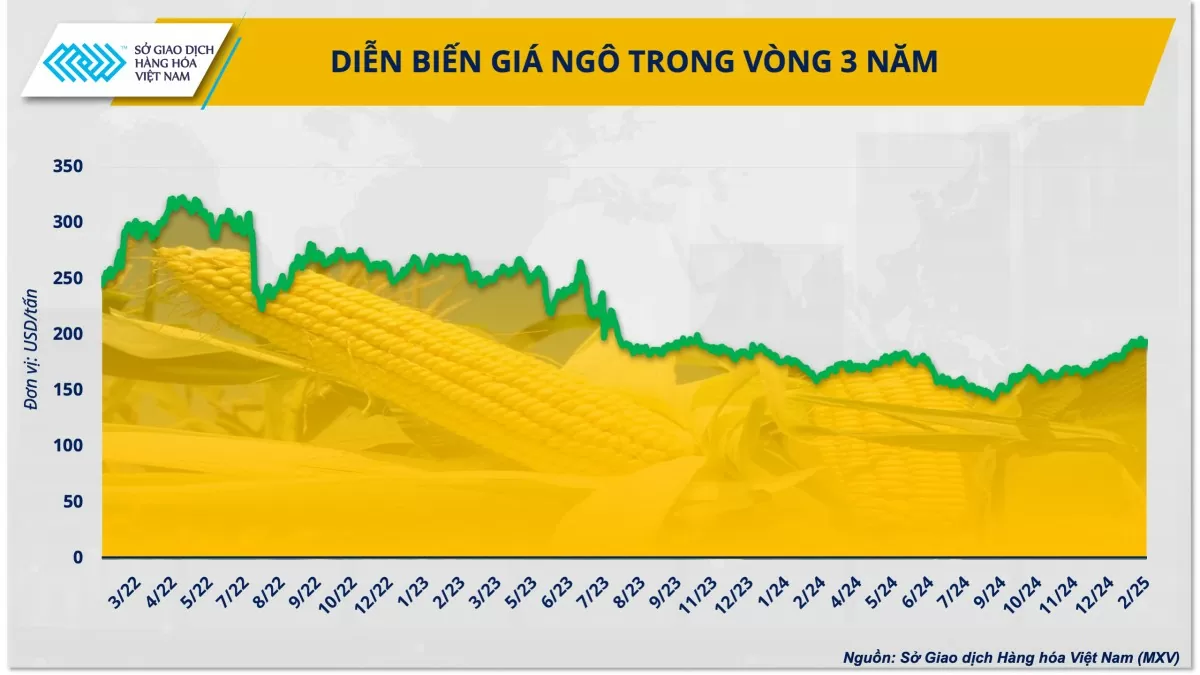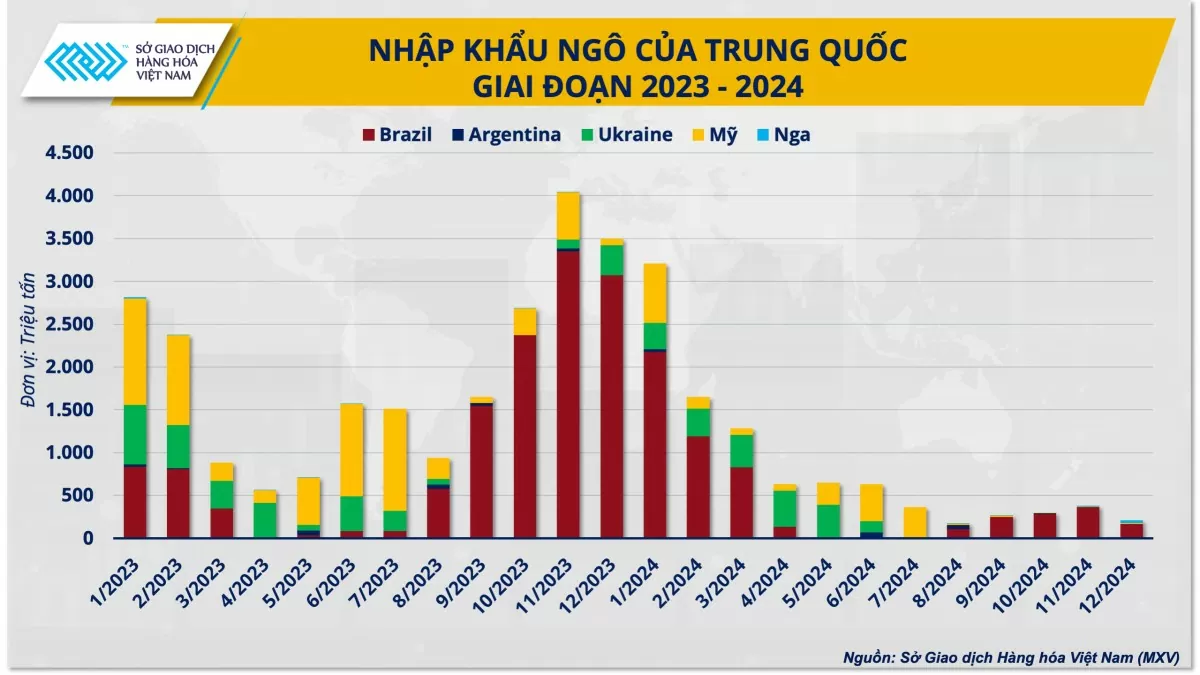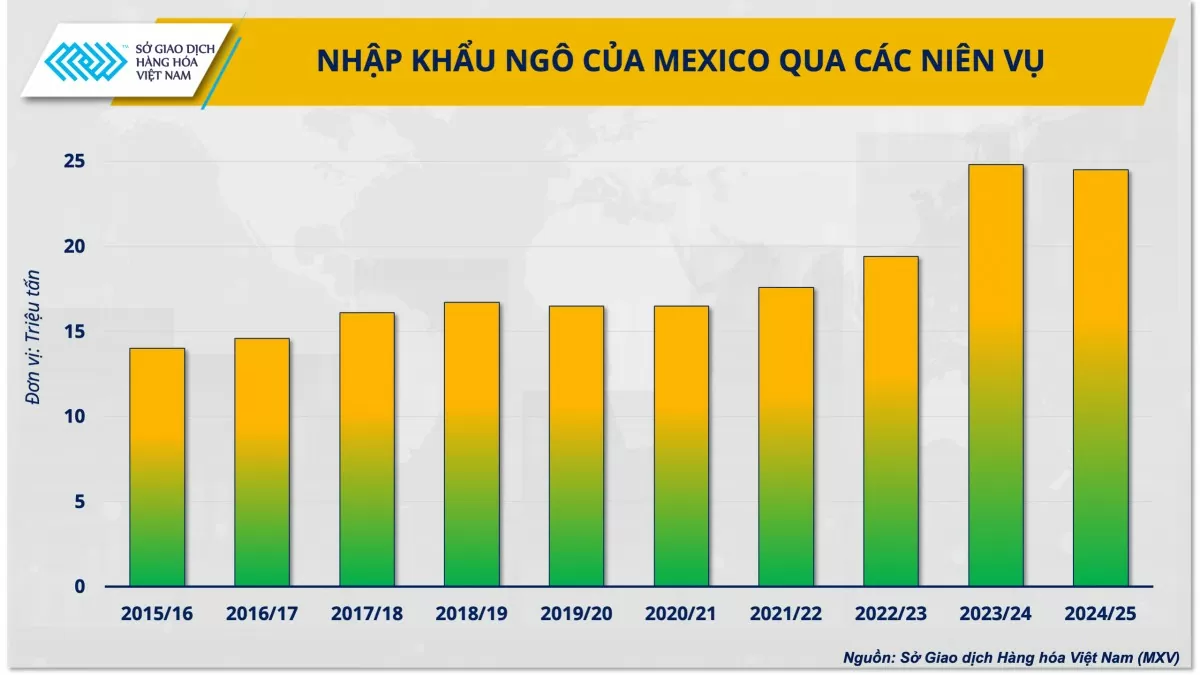According to MXV, as of the end of July 2024, the price of corn traded on the Chicago Mercantile Exchange had plummeted by more than 20% compared to the beginning of the year.
The global corn market has extended its decline for the second consecutive year, posing significant challenges for 2025. Fluctuations in economic and trade policies, along with weather forecasts, are expected to create an unpredictable picture for this agricultural commodity. Will corn have a chance to break through and regain its position after two years of stagnation? This will be a major question for investors and businesses in the new year.
Oversupply in the market is driving corn prices down.
Looking back at 2024, the corn market experienced relatively volatile fluctuations and ended the year with a slight decline. The Vietnam Commodity Exchange (MXV) reported that, as of the end of July 2024, corn prices traded on the Chicago Board of Commodities (CBOT) had plummeted by more than 20% compared to the beginning of the year. Notably, in the trading session on August 26th, corn prices fell to 361 cents/bushel (US$142.12/ton) – the lowest level since September 2020. However, prices quickly recovered strongly afterward, almost erasing the previous decline. This development demonstrates the volatile and unpredictable nature of the market, as prices are influenced by supply and demand factors.
 |
| Corn price trends over the past 3 years. |
On the supply side, global corn production remains high, particularly in the world's largest producing countries such as the United States, Brazil, and Argentina. According to data from the US Department of Agriculture (USDA), total global corn production for the 2023-2024 crop year reached 1.23 billion tons, an increase of 70,000 tons compared to the previous crop year. This abundant supply has contributed to upward pressure on prices.
Meanwhile, on the demand side, the corn market is also heavily influenced by the economic situation in China, the world's leading corn importer. Over the past year, the Chinese economy has continued to face difficulties due to the prolonged real estate crisis and economic stagnation. This has led consumers to tighten their spending, reducing demand for corn.
Following a surge in imports at the end of 2023, China's corn purchases gradually slowed down and were at a low level last year. According to data from Chinese Customs, the total volume of corn imports in 2024 decreased dramatically by more than 49% compared to the previous year, equivalent to 13.78 million tons. Brazilian corn remained the top choice due to its low price, followed by the US and Ukraine.
 |
| China's corn imports for the period 2023-2024 |
However, Mexico, the largest importer of US corn and the world's third-largest corn importer, maintained stable demand. This was a "bright spot" that helped US corn exports see a significant improvement in the final months of the year, thereby contributing to a strong recovery in CBOT corn prices.
Mr. Nguyen Ngoc Quynh, Deputy General Director of the Vietnam Commodity Exchange (MXV), noted that the corn market in 2024 experienced significant fluctuations with a tug-of-war between supply and demand factors. Although abundant supply from major producing countries such as the US, Brazil, and Argentina put downward pressure on prices, the strong recovery of CBOT corn prices at the end of the year showed the appeal of stable demand from key importing markets such as Mexico. In the current context, supply and demand factors, along with trade policies, will continue to be key determinants of corn price trends in the coming period.
 |
| Mr. Nguyen Ngoc Quynh – Deputy General Director of the Vietnam Commodity Exchange (MXV) |
What will the global corn market look like in 2025?
After two years of weakness, corn prices are showing signs of a strong recovery this year. However, according to MXV's forecast, the corn market will continue to be volatile and unpredictable due to the impact of supply and demand factors, international trade policies, and climate change.
For Mexico, which imports more than 15 million tons of U.S. corn annually, Trump's tariffs will worsen relations between the two countries. However, analysts believe Mexico is unlikely to abandon its supply of U.S. corn due to its geographical advantages and consistent quality. Transporting corn from Brazil or Argentina to Mexico takes twice as long and costs twice as much as transporting it from the U.S. This makes it difficult for Mexican food and animal feed processors to find an effective alternative.
 |
| Mexico's corn imports over the seasons. |
Meanwhile, China, the leading corn consumer, faces a difficult choice. If tensions escalate with the US, Beijing could impose retaliatory tariffs on US agricultural products, thereby diverting demand to Brazil and Argentina. This would inadvertently reduce China's diversification of supply sources. If supplies from South America are not as abundant as expected, China will be forced to carefully weigh food security against the trade war with the US.
The corn market is also expected to face threats from the return of La Nina. The World Meteorological Organization (WMO) says there is about a 55% chance that La Nina will return by the end of February 2025, but it could also occur between February and April with a similar probability of about 55%.
Typically, during La Nina years, crops in Brazil and Argentina face a variety of adverse weather conditions such as drought and frost. This is considered a "time bomb" for the global corn supply.
Historically, during the period of 2020-2023, corn prices rose for three consecutive years, largely due to the impact of La Nina on South American supply. The return of La Nina further increases crop risk this year, as the second corn crop, which accounts for 70-75% of Brazil's annual production, is expected to be planted later due to delays in soybean harvesting. Late planting increases the likelihood of adverse weather conditions later in the season. This could be a factor driving up corn prices in 2025.
The year 2025 is projected to see significant disruption in the structure of U.S. agricultural supply, as prices and trade policies become the determining factors in land allocation between the two staple crops, corn and soybeans. Corn and soybeans are crops produced at the same time of year in the U.S. and often compete for planting space during the growing season.
In 2024, both corn and soybean prices declined, although the decline in soybean prices was much greater than that of corn. Currently, the US corn-to-soybean price ratio is significantly lower than the benchmark of 2.5. This means that growing corn is now more profitable than growing soybeans.
 |
| Soybean price/corn price ratio |
According to an analysis by S&P Global Commodity Insights, the area planted with corn in the U.S. for the 2025 crop year is expected to increase by 3.2 million acres, reaching 93.5 million acres. Conversely, soybeans continue to lose ground, with an estimated acreage decrease of 4.3% (to 83.3 million acres). This reflects expectations that the U.S. corn supply will expand further next year.
However, this expansion also poses challenges regarding consumption capacity. If corn exports from the US to China and Mexico encounter difficulties, the surplus supply could cause CBOT corn prices to fall sharply.
In a scenario where US exports are not significantly affected by Trump's policies and crops in South America are impacted by bad weather, US supplies would receive attention from the market, thereby boosting exports.
Another factor expected to strongly influence prices next year is demand from China. After a year grappling with a real estate crisis and sluggish domestic consumption, China is striving to revive its economy through bold growth stimulus measures. If these measures prove effective, the country's corn consumption is expected to increase significantly, providing strong impetus for global corn prices.
China is a major corn importer, with demand primarily driven by the livestock and ethanol industries. With the Chinese government focusing on reviving domestic production and consumption, corn demand is expected to improve. However, the extent of this recovery will depend on the effectiveness of economic policies as well as the consumption of meat and other livestock products.
Demand from China is likely to be a key factor determining the direction of corn prices in 2025. However, specific developments still need to be closely monitored given the volatile economic environment.
| According to MXV, 2025 is projected to be a challenging year but also one with many opportunities for the global corn market. Large supplies from the US and South America could continue to put downward pressure on prices, especially if the Trump administration's trade policies impact exports. However, the return of La Nina and crop delays in South America could provide a boost to corn prices. In the context of a volatile global economy, investors need to closely monitor trade policy developments and crop yields to make informed trading decisions. |
Source: https://congthuong.vn/thi-truong-ngo-the-gioi-2025-thach-thuc-song-hanh-cung-co-hoi-373593.html







![[Photo] Two flights successfully landed and took off at Long Thanh Airport.](/_next/image?url=https%3A%2F%2Fvphoto.vietnam.vn%2Fthumb%2F1200x675%2Fvietnam%2Fresource%2FIMAGE%2F2025%2F12%2F15%2F1765808718882_ndo_br_img-8897-resize-5807-jpg.webp&w=3840&q=75)






























































































Comment (0)